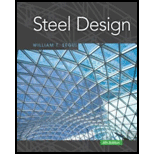
Concept explainers
A beam is part of the framing system for the floor of an office building. The floor is subjected to both dead loads and live loads. The maximum moment caused by the service dead load is 45 ft-kips, and the maximum moment for the service live load is 63 ft-kips (these moments occur at the same location on the beam and can therefore be combined).
a. If load and resistance factor design is used, determine the maximum factored bending moment (required moment strength). What is the controlling AISC load combination?
b. What is the required nominal moment strength for a resistance factor
c. If allowable strength design is used, determine the required moment strength. What is the controlling AISC lead combination?
d. What is the required nominal moment strength for a safety factor
Trending nowThis is a popular solution!

Chapter 2 Solutions
Steel Design (Activate Learning with these NEW titles from Engineering!)
Additional Engineering Textbook Solutions
Starting Out with Python (4th Edition)
SURVEY OF OPERATING SYSTEMS
Vector Mechanics for Engineers: Statics and Dynamics
Java: An Introduction to Problem Solving and Programming (8th Edition)
Database Concepts (8th Edition)
Degarmo's Materials And Processes In Manufacturing
- In a simulation experiment on a single lane road, one vehicle is travelling at 18 m/s.After 1.5seconds, the vehicle suddenly accelerates at a rate of 1.5 m/s2 for the next2 seconds and remains0 acceleration then after. Simulate the behavior of subsequent vehicle with an initial speedof16 m/s using GM car following model for the first 3 seconds if the initial distanceheadwayis 20 m. Tabulate the results. Assume headway exponent 1.2, speed exponent1.5, sensitivitycoefficient 0.8, reaction time 0.6 seconds, and update interval of0.3 seconds.arrow_forwardFORWARD FROM POINT B TO POINT A GIVEN THE FOLLOWING: POINT BN=13,163,463.03'E=3,072,129.30' DIRECTION FROM B TO A (NAZ)=276.07529° DISTANCE FROM B TO A = 10.00'arrow_forwardIt proposed to provide pile foundation for a heavy column; the pile group consisting of 4 piles. placed at 2.0 m centre to centre, forming a square pattern. The under-ground soil is clay, having cu at surface as 60 kN/m², and at depth 10 m, as 100 kN/m². Compute the allowable column load on the pile cap with factor of safety of 3.0, if the piles are circular having diameters 0.5 m each and length as 10 m.arrow_forward
- At a particular section on a highway the following headways are observed: 0.04, 1.37,1.98,5.09, 3.00, 2.32, 2.54, 1.37, 0.94, 1.79, 1.10, 6.24, 4.82, 2.77, 4.82, 6.44. Fit an exponentialdistribution and compare the observed and estimated mean. Check the fit at the 5% level ofsignificance.arrow_forwardH.W: 1. Find the center of mass and the moment of inertia and radius of gyration about the y-axis of thin rectangular plate cut from the first quadrant by the lines x = 6 and y = 1 if (x, y) = x+y+1 2. Find the moment of inertia and radius of gyration about the coordinate axes of a thin rectangular plate of constant density & bounded by the lines x = 3 and y = 3 in the first quadrant.arrow_forwardPlease solve manually and follow all rules for flow net construction. Provide a scale such that the flow net produced can be copied.arrow_forward
- Please solve manually, and give any tips on how I can manually recreate the flow net you provide. Thanks.arrow_forwardA group of nine piles. 12m long and 350 mm in diameter, is to be arrenged in a square form in clay soil with an average unconfined compressive strength of 60 KN/m^2. Work out center to center spacing of the piles for a group effeciency factor of 1, Neglect bearing at the tip of the piles.arrow_forwardSOLVE BY NEWTON - RAPHSON METHOD: The equation x³-3x-4=0 is of the form f(x) = 0 where f(1) 0 so there is a solution to the equation between 1 and 3. We shall take this to be 2, by bisection. Find a better approximation to the root.arrow_forward
- Kindly help to provide answers, elaborate with examples and provide useful links for learning purposes. this is regarding building diagnosis.arrow_forwardpounds of steel need to be purchased for the roof plan a table with various steel types and the quantity needed The colums are 18 feet high and weigh 76 ponds per foot include a structural steel material list for the roof framing planarrow_forwardHomework: Determine the proportions of the separate aggregates that will give a gradation within the SCRB wearing coarse specified limits for the aggregates and mix composition for highway pavement asphaltic concrete. The table below shows the results of sieve analysis of samples from the materials available. برو Percent by Weight Passing Sieve Designation Retained on Sieve Designation Coarse Aggregate Fine Aggregate Mineral Filler 3/4 in. (19 mm) 1/2 in. 5 ½ in. (12.5 mm) 3/8 in. 35 ¾ in. (9.5 mm) No. 4 38 No. 4 (4.75 mm) No. 10 17 No. 10 (2 mm) No. 40 5 No. 40 (0.425 mm) No. 80 No. 80 (0.180 mm) No. 200 No. 200 (0.075 mm) Total 18 1118 30 35 5 26 35 60 100 100 100arrow_forward
 Steel Design (Activate Learning with these NEW ti...Civil EngineeringISBN:9781337094740Author:Segui, William T.Publisher:Cengage Learning
Steel Design (Activate Learning with these NEW ti...Civil EngineeringISBN:9781337094740Author:Segui, William T.Publisher:Cengage Learning
 Residential Construction Academy: House Wiring (M...Civil EngineeringISBN:9781285852225Author:Gregory W FletcherPublisher:Cengage Learning
Residential Construction Academy: House Wiring (M...Civil EngineeringISBN:9781285852225Author:Gregory W FletcherPublisher:Cengage Learning Materials Science And Engineering PropertiesCivil EngineeringISBN:9781111988609Author:Charles GilmorePublisher:Cengage Learning
Materials Science And Engineering PropertiesCivil EngineeringISBN:9781111988609Author:Charles GilmorePublisher:Cengage Learning Engineering Fundamentals: An Introduction to Engi...Civil EngineeringISBN:9781305084766Author:Saeed MoaveniPublisher:Cengage Learning
Engineering Fundamentals: An Introduction to Engi...Civil EngineeringISBN:9781305084766Author:Saeed MoaveniPublisher:Cengage Learning Principles of Foundation Engineering (MindTap Cou...Civil EngineeringISBN:9781305081550Author:Braja M. DasPublisher:Cengage Learning
Principles of Foundation Engineering (MindTap Cou...Civil EngineeringISBN:9781305081550Author:Braja M. DasPublisher:Cengage Learning





